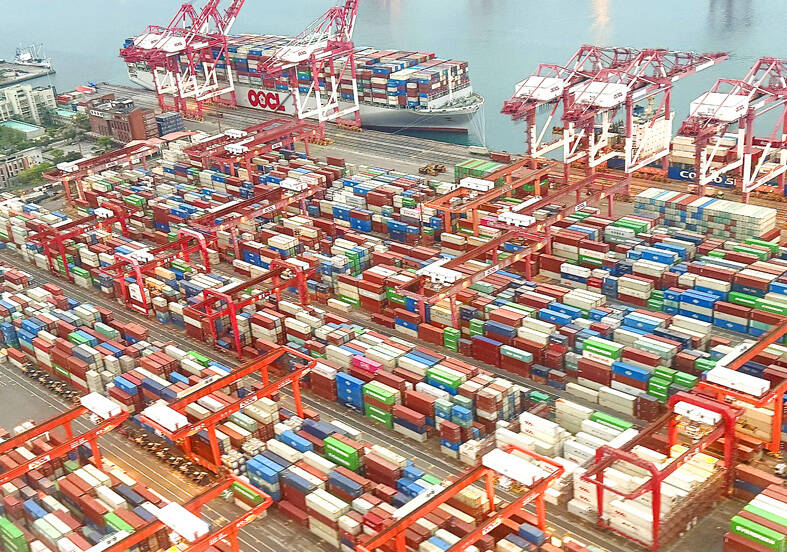All products manufactured in Taiwan and exported to the US must include a signed declaration of origin starting on May 7, the Bureau of Foreign Trade announced yesterday.
US President Donald Trump on April 2 imposed a 32 percent tariff on imports from Taiwan, but one week later announced a 90-day pause on its implementation. However, a universal 10 percent tariff was immediately applied to most imports from around the world.
On April 12, the Trump administration further exempted computers, smartphones and semiconductors from the new tariffs.

Photo: CNA
In response, President William Lai’s (賴清德) administration has introduced a series of countermeasures to support affected industries.
Meanwhile, the US currently imposes a 145 percent tariff on all Chinese goods, while China has retaliated by levying a 125 percent tariff on all US exports.
The bureau said that the US tariff policies would incentivize countries facing higher tariffs to reroute their goods through nations with lower tariff rates by altering source-of-origin labels, repackaging, or applying minimal processing before exporting to the US.
The Lai administration wishes to avoid the possibility of Chinese goods being rerouted through Taiwan, as such practices would damage Taiwan’s international credibility and undermine its efforts to secure preferential tariffs with the US, the bureau said.
The signed declaration of origin represents a commitment between businesses and the government to work together to prevent China from “whitewashing” the origin of its products and using Taiwan as a channel to circumvent US tariffs, it added.
Starting on May 7, the declaration form would be a mandatory document for all exports to the US, the bureau said, adding that exports without the required documentation would be barred from clearing customs.
While existing regulations already require products made in Taiwan to be labeled accordingly, either internally or externally, exporters sometimes forget to label their goods, the bureau said, adding that the declaration form would serve as a further reminder.
Failure to comply with the new rules could result in fines ranging from NT$60,000 to NT$3 million (US$1,845 to US$92,234), it added.
Per Premier Cho Jung-tai’s (卓榮泰) statements, products made in Taiwan must be clearly designated as such, and the new declaration requirement is not intended to restrict exports, the bureau said.
Instead, it serves as a signal that businesses are willing to cooperate with the government to prevent China from “whitewashing” the origin of its products and using Taiwan to evade US tariffs, it added.
The bureau was referring to Cho’s remarks during a meeting with representatives of the fastener industry on April 13 in Kaohsiung, where he said that the US is highly concerned about issues related to origin washing.
The US does not apply a single, fixed standard to determine the origin of goods; instead it makes determinations on a shipment-by-shipment basis, the Ministry of Economic Affairs said.
Exporters are advised to review previous US rulings, remain in constant communication with their US clients and consider applying to US Customs and Border Protection for preclearance to protect their rights and interests, it said.

TRAGEDY STRIKES TAIPEI: The suspect died after falling off a building after he threw smoke grenades into Taipei Main Station and went on a killing spree in Zhongshan A 27-year-old suspect allegedly threw smoke grenades in Taipei Main Station and then proceeded to Zhongshan MRT Station in a random killing spree that resulted in the death of the suspect and two other civilians, and seven injured, including one in critical condition, as of press time last night. The suspect, identified as a man surnamed Chang Wen (張文), allegedly began the attack at Taipei Main Station, the Taipei Fire Department said, adding that it received a report at 5:24pm that smoke grenades had been thrown in the station. One man in his 50s was rushed to hospital after a cardiac arrest

SAFETY FIRST: Double the number of police were deployed at the Taipei Marathon, while other cities released plans to bolster public event safety Authorities across Taiwan have stepped up security measures ahead of Christmas and New Year events, following a knife and smoke bomb attack in Taipei on Friday that left four people dead and 11 injured. In a bid to prevent potential copycat incidents, police deployments have been expanded for large gatherings, transport hubs, and other crowded public spaces, according to official statements from police and city authorities. Taipei Mayor Chiang Wan-an (蔣萬安) said the city has “comprehensively raised security readiness” in crowded areas, increased police deployments with armed officers, and intensified patrols during weekends and nighttime hours. For large-scale events, security checkpoints and explosives

PUBLIC SAFETY: The premier said that security would be tightened in transport hubs, while President Lai commended the public for their bravery The government is to deploy more police, including rapid response units, in crowded public areas to ensure a swift response to any threats, President William Lai (賴清德) said yesterday after a knife attack killed three people and injured 11 in Taipei the previous day. Lai made the remarks following a briefing by the National Police Agency on the progress of the investigation, saying that the attack underscored the importance of cooperation in public security between the central and local governments. The attack unfolded in the early evening on Friday around Taipei Main Station’s M7 exit and later near the Taipei MRT’s Zhongshan

A car bomb killed a senior Russian general in southern Moscow yesterday morning, the latest high-profile army figure to be blown up in a blast that came just hours after Russian and Ukrainian delegates held separate talks in Miami on a plan to end the war. Kyiv has not commented on the incident, but Russian investigators said they were probing whether the blast was “linked” to “Ukrainian special forces.” The attack was similar to other assassinations of generals and pro-war figures that have either been claimed, or are widely believed to have been orchestrated, by Ukraine. Russian Lieutenant General Fanil Sarvarov, 56, head